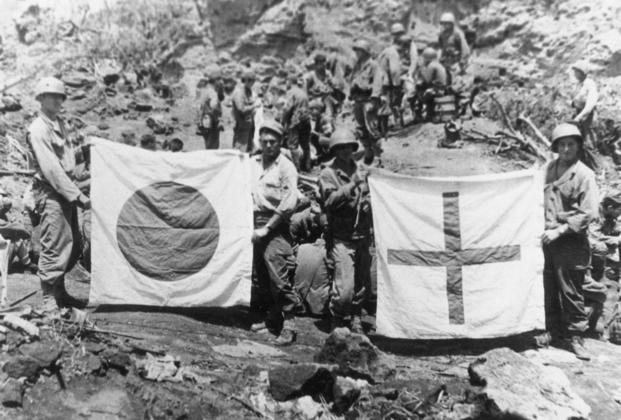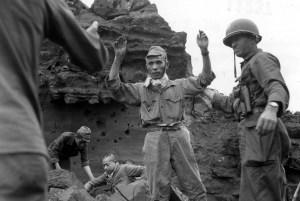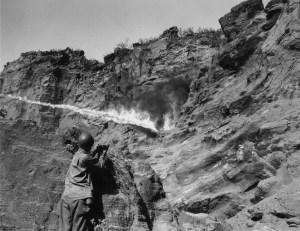From Guadalcanal to Okinawa, the Marine Corps earned its reputation for tackling some of the bloodiest battles of World War II’s Pacific Theater. What few remember is that the U.S. Army usually fought alongside the Marines through some of the fiercest battles in history.
However, only one Army regiment — the 147th Infantry — stood shoulder to shoulder with Marines in five of the toughest Pacific campaigns. Its soldiers fought in the same jungles, on the same beaches and across the same volcanic rock, yet their story remains largely unknown.
The 147th Infantry: From the Buckeye Division to the Pacific Theater
The 147th Infantry Regiment was originally part of the Ohio National Guard’s 37th Infantry Division. When the Army reorganized its divisions in 1942 from four regiments to three, the 147th was cut loose and became an independent regiment.
That independence meant it could be sent wherever it was needed most. Instead of fighting as part of a larger division, the 147th was repeatedly attached to Marine units fighting in the Pacific. Independent units like this were usually tasked with holding ground, clearing out bypassed Japanese positions and doing the dangerous work of rooting out survivors after the main battles ended.
It was an unusual role for an Army unit, and it soon placed the regiment on the front lines of nearly every major Marine fight in the Pacific.
The Battle of Guadalcanal
The regiment’s baptism by fire came on Guadalcanal in late 1942 and early 1943. Japanese forces had already been hammered for months, but thousands dug in around the ridges of Mount Austen. The 147th would eventually be called upon to help the other troops take the position.
According to the Army’s official history, on January 20, 1943, “the 3d Battalion, 147th … began moving into the front line between the 6th Marines and the 182d Infantry” during the final push to eliminate Japanese resistance. General Alexander Patch combined the 147th, the 182nd Infantry and the 6th Marines into the Composite Army-Marine Division.
For several weeks, the soldiers and Marines hacked through dense jungle, crossed rivers under fire and fought bitterly for every ridge. By the time Guadalcanal was declared secure on Feb. 9, 1943, the 147th had lost dozens of men but proved it could fight in some of the Pacific’s harshest terrain.
The U.S. Army on Saipan and Tinian
After garrison duty on several smaller islands, the 147th returned to combat in the summer of 1944 during the invasions of Saipan and Tinian.
On Saipan, the regiment landed behind the Marine divisions and the Army’s 27th Infantry Division. It was tasked with clearing caves, bunkers and pillboxes that often concealed diehard Japanese defenders that were bypassed by the main force.
The soldiers had to resort to using satchel charges and flamethrowers to prevent Japanese troops from launching surprise attacks against unsuspecting rear-echelon troops. Even after Saipan was officially secured, the 147th fought skirmishes against stragglers who refused to surrender.
A few weeks later, the regiment landed on the nearby island of Tinian. There, the men perfected their brutal craft. They again used flamethrowers, satchel charges and grenades to burn or blast Japanese soldiers out of caves and tunnels. These tactics, refined in the Marianas, would define the regiment’s role for the rest of the war.

The Marine Corps and Iwo Jima
The regiment’s toughest assignment came on Iwo Jima in March 1945. Although the battle remains the largest all-marine amphibious assault in history, the Army played their part in the engagement.
After the Marines captured the island’s airfields in the first week of the engagement, thousands of Japanese soldiers still hid in the island’s underground tunnel complexes. The 147th was brought in to root these troops out while the Marines finished securing the island.
They became known as the “Cave Men.” Pvt. James McGuire of Company B recalled, “Our company formed teams equipped with guts, flashlights and pistols.”
Platoon leader James J. Ahern described the dangers bluntly: “I threw in a white phosphorous grenade and the Jap threw it back… I tossed in a fragmentation grenade and the Jap threw it back… This got my dander up. I cleared the cave with a flamethrower.”
For three months, the regiment hunted down Japanese troops who tried to escape or ambush them. Fifteen men were killed and 144 wounded, but the 147th killed more than 1,600 Japanese and captured nearly 900 more. Thousands of others were sealed inside their tunnels forever.
Lt. Gen. Robert C. Richardson, commanding Army forces in the Pacific, commended the regiment for its “consistent courage and combat ingenuity … in dealing with an enemy determined upon a course of fanatical resistance.”

The Final Battle on Okinawa
Fresh from Iwo, the 147th landed on Okinawa in April 1945. After the collapse of organized Japanese resistance, the regiment again turned to cave-clearing operations, applying its hard-earned tactics in the final bloody battle of the Pacific.
Dozens of troops from the regiment were killed or wounded, trying to root out the last fanatical Japanese troops on the island. Like on Iwo, the soldiers had to resort to simply sealing the caves, forever trapping the enemy underground. By the end of the summer, the island was declared secure, and with it the road to Japan itself lay open.
One battalion from the regiment was sent back to Tinian, where the men helped guard the components for the atomic bombs that would destroy Hiroshima and Nagasaki. Following the end of the war in September 1945, the regiment was rotated back home with little fanfare.

A Forgotten Regiment with a Unique Distinction
Despite its record, the 147th remains relatively unknown. Its independent status meant the regiment had no divisional patch that could earn recognition, no large public identity, and it usually operated in the shadows of the Marine Corps. The Marines, rightly, received widespread public recognition for their costly assaults throughout the Pacific.
The Army, despite constituting the vast majority of the troops numbers in the theater and conducting the majority of amphibious assaults, are often forgotten. The soldiers of the 147th fighting beside the Marines or mopping up behind them, rarely saw their names in the headlines.

Yet their achievements were impressive. Over the course of the war, the regiment fought in more landings, cleared more caves and killed or captured more enemy troops than many Marine regiments. On Iwo Jima alone, their tally of enemy killed and captured amounted to nearly 10 percent of the island’s entire Japanese garrison.
In recent years, historians have begun to restore the regiment’s place in WWII history. On the 75th anniversary of Iwo Jima in 2020, veterans’ accounts brought the danger of their work back into the spotlight. “Daytime or nighttime, combat action on Iwo Jima was always exciting. The risks were there, some days were more adventurous than others,” Ahern said.
The regiment may not have raised a flag on Mount Suribachi, but it fought — and bled — in five of the Marine Corps’ toughest battles. Its legacy is a reminder that the Army, too, paid heavily in the island war against Japan, and that victory in the Pacific was a joint effort.
Story Continues
Read the full article here



